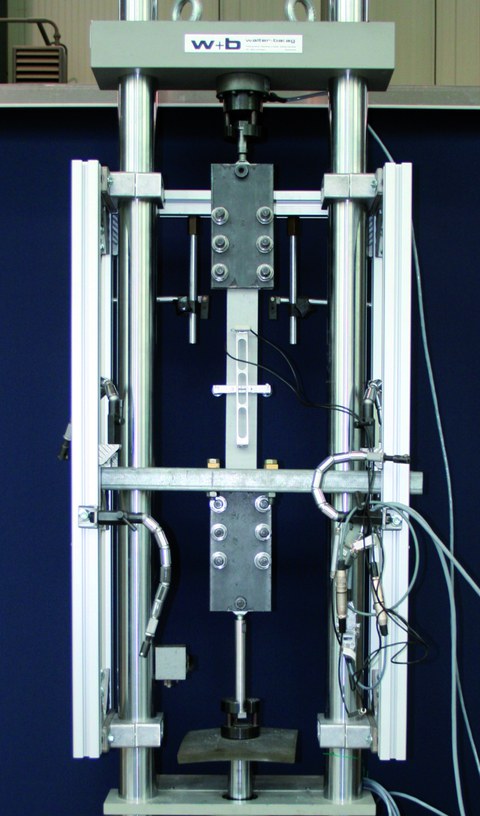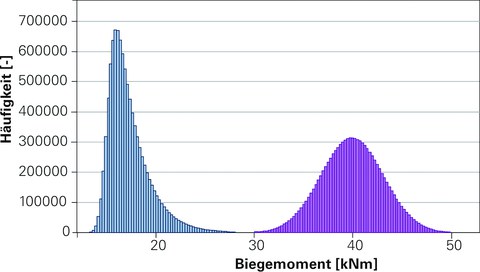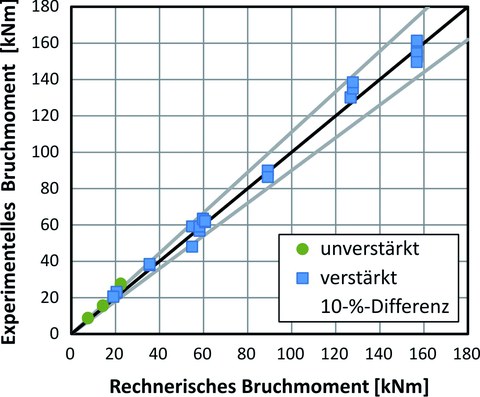General building approval of a procedure for the strengthening of RC with TUDALIT® (Textile Reinforced Concrete)
Table of contents
Project data
|
Titel | Title |
Report in the yearbook 2013
Textile reinforced concrete – extended tests for safe usage

Fatigue test
The use of textile reinforced concrete in construction increases constantly. Consequently, the granting of approvals in each case or general type approvals will gain in importance.
So far, the greater part of research has dealt with the behaviour of textile reinforced concrete under loads in relatively short periods. However, for use in construction and the corresponding required material constants and tensile strength values it has to be taken into consideration that a building or component is usually loaded permanently as well as in part with dynamic loads. At the same time it is exposed to different climatic conditions. As a result, short-time tests in an indoor environment have to be carried out as well as tests which are adapted to the respective design goal to guarantee the durability of the composite material for the target service life. In this context temperature load, longterm tests and fatigue tests are relevant.
With the aim of retaining the tensile strength and bond values under temperature load and, if applicable, in humidity, tests are carried out in climatic chambers or through the use of thermal radiators. Apart from this, the long-term strength can be tested for a defined permanent load and specific period. After the temperature or the permanent loads have been applied to the samples, the residual strength is determined. Subsequently, these strength values are comparable to the reference values determined in the short-time tests in indoor environment.
To prove the fatigue strength of textile reinforced concrete systems, dynamic tests are carried out to depict the predominantly non-static loads. The working stroke is defined based on the future application such as the strengthening of bridges.
These examination methods, which have been developed as part of the research at the Institute of Concrete Structures at TU Dresden, are already successfully employed. Amongst others, they were part of the tests carried out to achieve general type approval for a strengthening method with textile reinforced concrete. Approval will probably be granted in the first quarter of 2014. In this way, they contribute to a significant degree to the safe use of textile-reinforced concrete and are an important step for usage of the material in construction on a broad scale.
Report in the yearbook 2013 - part safety
How safe is TRC?

Comparison between load-influence on (blue) and resistance of the component (purple).
Since textile reinforced concrete – also known as TRC − has been developed inter alia at the Institute of Concrete Structures of the TU Dresden as a new building material in the past 15 years, it should also be used in construction of course. This requires a building authority approval, which is awarded by the German Institute for Building Technology DIBt if it can be guaranteed that the product meets all safety requirements.
To prove this, several hundred tests of various setups and kinds were carried out under an authorization procedure to check the TRC. The completion of these experiments is imminent and therefore a reliability concept for textile-reinforced concrete had to be developed.
The process was modelled on the concept of partial safety factors, which has already proven itself in reinforced concrete. Since reinforced concrete is established and sufficiently secure, it was used as reference.
First a reference component was dimensioned for both composite materials and then each probability of failure was calculated. Toward this aim, a safety factor for textile reinforced concrete was estimated in the first step. Subsequently, the design was carried out in the same way as would be done to determine the required reinforcement for a reinforced concrete component. Then the calculation was repeated with a probabilistic method, which is based on stochastic. This means that all previous tests were statistically analysed. Thus, the mean variation of the building material and with the help of literature also the expected loads can be taken into account exactly. With the probabilistic proof the failure probability was calculated for the fictional component based on the reinforcement quantities initially determined for steel and textile concrete each. The failure probability then results from the intersection of the loads’ influences on the building material and its bearing capacity. Then the failure probability of both components was compared, and the calculation process was repeated with the modified safety factor until the probability of failure of the textile concrete was smaller than that of the reinforced concrete.
So the initial question „How safe and reliable is textile reinforced concrete?“ can be answered with: „As safe as reinforced concrete!
Report in the yearbook 2012
Flexural strengthening with TRC

Experimental versus numerical bending moment
For more than twelve years, textile reinforced concrete (TRC) has been intensively researched and developed in the DFG collaborative research centre (CRC) 528 „Textile Reinforcements for Structural Strengthening and Repair“. The bearing mechanisms, potentials and limitations of use of this innovative material have been demonstrated in theory and practice.
However, a general building inspection approval is essential for the practical implementation of textile reinforced concrete. In cooperation with the TUDALIT e.V. and the TU Dresden Aktiengesellschaft (TUDAG), a formal application for such an approval was made to the German Institute for Civil Engineering (DIBt) in September 2009. It is part of the approval procedure to present for instance evidences for the suitability and admissibility of the input variables, material constants and design methods suggested by the applicant. Furthermore, numerous approval tests have to be carried out. Subsequently, these have to be developed in models before the reinforcement methods can be put into practice.
One part of the tests that are to be carried out shall prove the suitability of textile reinforced concrete for the flexural strengthening of steel reinforced structural members. To achieve this goal, more than 30 slab strips with lengths from 3.30 m to
7.30 m and thicknesses between 12 cm and 30 cm were made of reinforced concrete and then strengthened with TRC. The slab strips differ not only in their geometries, but also the steel or textile reinforcement ratio, the concrete cover and the diameter of the steel. The selection of the slab configurations (limit values) defines the scope of the general building inspection approval.
The slabs were produced and strengthened in a batch plant. The four point bending tests leading up to tensile failure of the textile reinforcement were conducted at the Otto-Mohr-laboratory. The load bearing capacity of the slabs was also examined in theory. This could be done based on calculation methods which had already been developed and optimized as part of the CRC 528. A comparison between the theoretically and practically determined bending moments showed that the proposed calculation method for the design of a flexural strengthening with textile reinforced concrete can be recommended without reservations.
